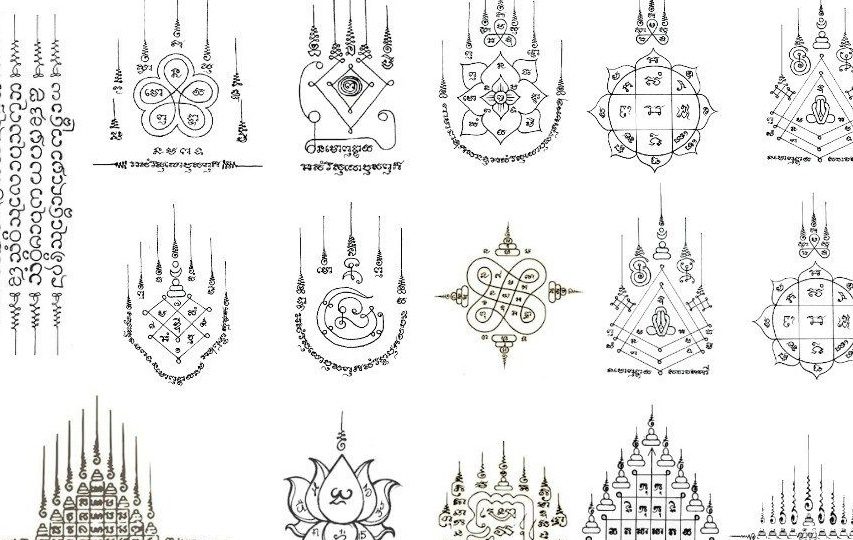
Exploring Thai Sak Yant Tattoos and Yantra Tattooing
Hey there, culture and art enthusiasts! Today, let’s dive into the fascinating world of Thai Sak Yant tattoos, a form of body art that’s rich in mystique and deep spiritual meaning.
What is a Thai Sak Yant Tattoos or Yantra Tattoo?
A Sak Yant tattoo, often referred to as Yantra tattooing, is a sacred form of body art from Thailand. While “Sak Yant” is the Thai term, “Yantra tattooing” refers to the same mystical practice but emphasizes the spiritual symbols, or “yantras,” used in the designs. This isn’t just any tattoo—it’s a form of ancient spiritual protection with a history that stretches over 2,000 years.

The Ancient Origins of Yantra Tattooing
Sak Yant, or Yantra tattooing, originated in Southeast Asia, with Thailand being a prominent hub for this sacred art. In ancient times, warriors and soldiers would receive these tattoos, believing they provided mystical protection in battle. The term “Yantra” comes from Sanskrit, meaning a sacred diagram. Combined with the Thai word “Sak” (which means to tattoo), Sak Yant refers to the practice of tattooing these sacred yantras onto the skin, invoking spiritual power.
The Spiritual Significance Behind Sak Yant Tattoos and Yantra Tattooing
Each Yantra tattoo design carries its own spiritual meaning. Some feature Buddhist or Hindu symbols, while others use intricate geometric patterns or sacred mantras known as “Kata.” Written in ancient Khmer script, these mantras are believed to offer powerful blessings, like protection from harm, good fortune, success, and even invincibility.
Popular Sak Yant Tattoos and Yantra Tattoo Designs
- Hah Taew (Five Sacred Lines): This popular design represents five blessings, including protection, success, and good fortune. It’s a top choice for those seeking general protection and happiness.
- Gao Yord (Nine Peaks): Also called Yant Kroo, this design symbolizes the sacred Mount Meru from Hindu and Buddhist cosmology. It’s a powerful protective amulet against accidents and evil spirits.
- Paed Tidt (Eight Directions): This design features arrows pointing in eight directions, providing protection from all sides. It’s perfect for frequent travelers or those seeking protection in all areas of life.
- Tiger Yant: A favorite among those seeking strength, power, and leadership, this tattoo represents confidence and protection in both personal and professional life.
- Hanuman Yant: Depicting the Hindu monkey god Hanuman, this design symbolizes bravery, strength, and fearlessness. It’s ideal for those who need courage to overcome challenges.

The Ritual Behind Getting a Sak Yant or Yantra Tattoo
The process of getting a Sak Yant or Yantra tattoo is not like getting a modern tattoo. Traditionally, these tattoos are applied by monks or Ajarns (spiritual teachers) in temples or sacred places. This isn’t just a tattoo session—it’s a spiritual ceremony. As the monk or Ajarn tattoos you, they chant prayers, activating the mystical power of the tattoo and connecting the wearer to spiritual energy.
Unlike modern tattoo machines, a long, sharp metal rod or bamboo needle is used in Yantra tattooing. While this method may be more painful, many believe the pain is an essential part of the spiritual experience. After the tattoo is complete, the monk or Ajarn blesses it, making the tattoo “come to life” with the desired protection or benefit.
A Sacred Commitment Beyond the Tattoo
Yantra tattooing is more than just body art—it’s a spiritual commitment. Many monks and Ajarns recommend that those who receive Sak Yant tattoos follow certain moral guidelines, known as “Sila,” which are similar to the Buddhist “Five Precepts.” This means avoiding actions like killing, lying, or stealing, as breaking these moral codes can weaken or even nullify the tattoo’s spiritual power.
Should You Get a Sak Yant or Yantra Tattoo?
Deciding to get a Sak Yant tattoo or undergo Yantra tattooing is a deeply personal choice. First and foremost, it’s essential to respect the sacred nature of these tattoos. If you’re drawn to their spiritual significance, don’t get one just for its aesthetic appeal. Instead, take time to understand and appreciate the rich cultural and religious meaning behind these designs.
Consider your own spiritual beliefs as well. If you don’t believe in the spiritual power of the tattoo, it may not hold much value for you. It’s also crucial to find a reputable practitioner. For an authentic experience, seek out an experienced monk or Ajarn. Lastly, be prepared to commit to living a moral and mindful life, as Sak Yant tattoos are not just about the design—they symbolize a commitment to live with integrity.
Final Thoughts
If you’re considering getting a Sak Yant tattoo or experiencing Yantra tattooing during a trip to Thailand, take a moment to reflect. These tattoos are far more complex than they seem. Respect their sacred nature, understand the cultural and religious significance, and ensure your beliefs align with their spiritual power. And most importantly, find a reputable and experienced practitioner—preferably a monk or Ajarn—so you can fully appreciate the depth and meaning of this sacred art.
Get to Know Free Numerology Chart
Get to Know More about Feng Shui












